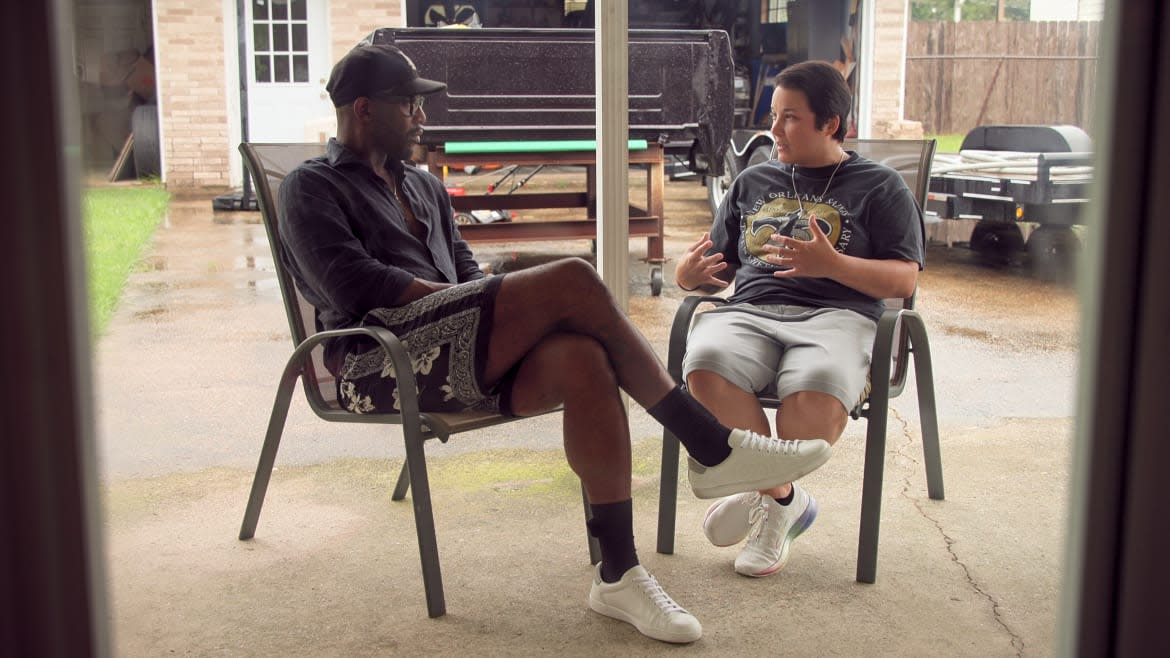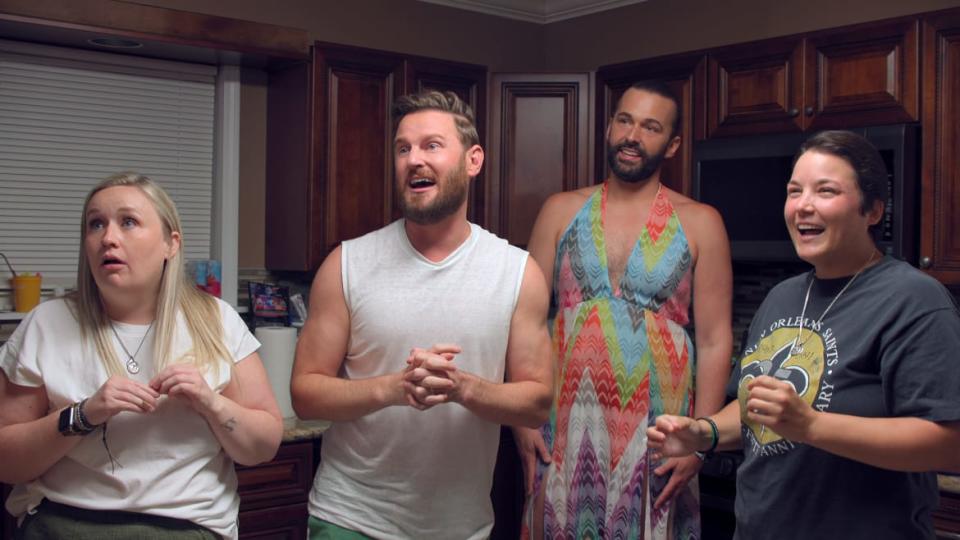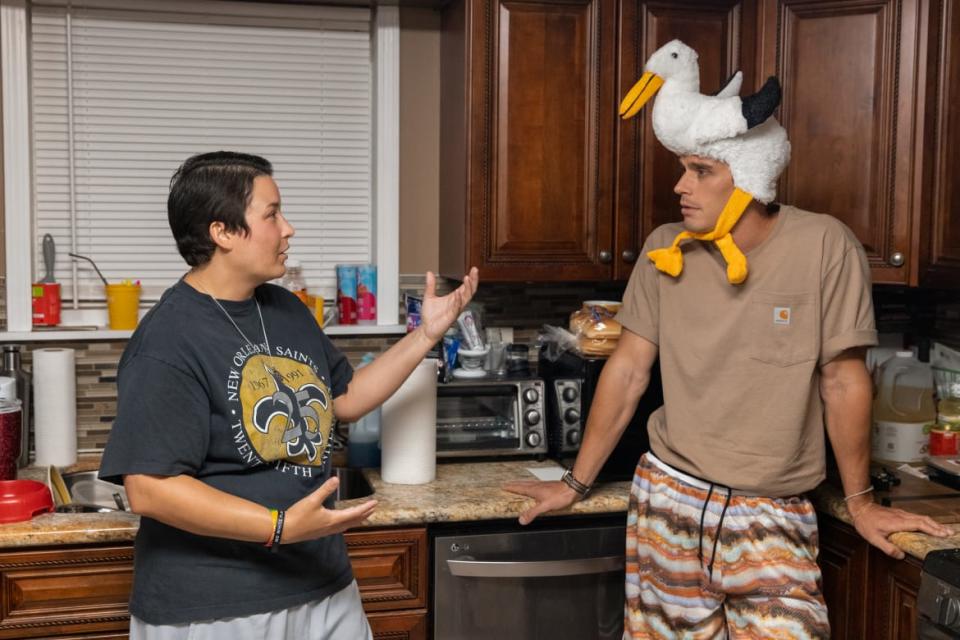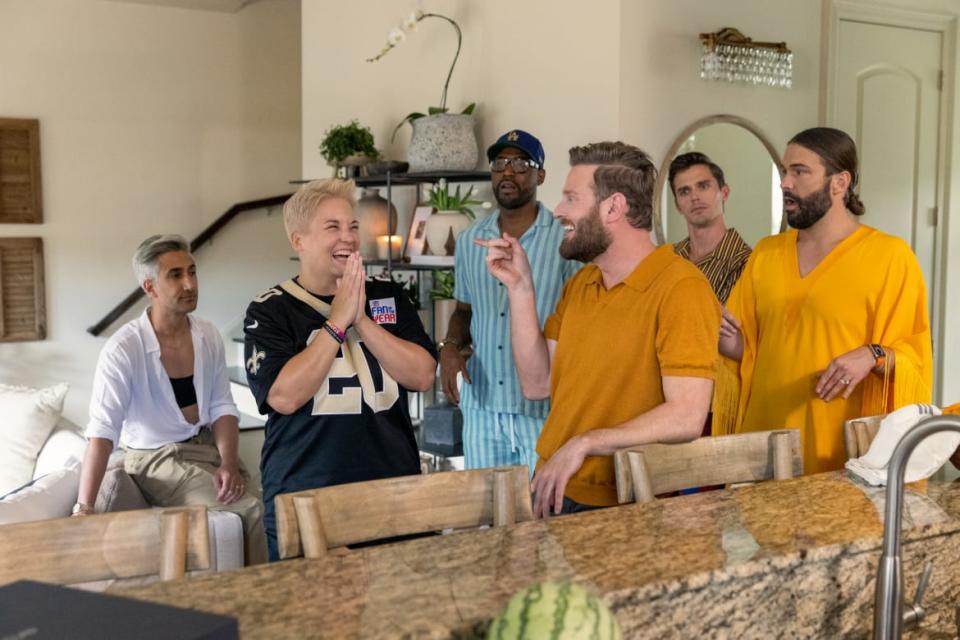‘Queer Eye’ Takes on Internalized Homophobia in Its Best Episode Yet

- Oops!Something went wrong.Please try again later.
- Oops!Something went wrong.Please try again later.
- Oops!Something went wrong.Please try again later.
- Oops!Something went wrong.Please try again later.
- Oops!Something went wrong.Please try again later.
- Oops!Something went wrong.Please try again later.
Queer Eye has gone from a sleeper hit to one of Netflix’s biggest shows. The series features five glorious queers—Antoni Porowski, Jonathan Van Ness, Tan France, Karamo Brown, and Bobby Berk—surprising people across the country and transforming their lives for the better in just one week. Plenty of reality television is rooted in conniving drama and shocking twists, but Queer Eye offers something far more uplifting, wholesome message. Considering that the world often feels like a slow-motion car crash these days, it’s no wonder the show has taken off.
One of the reasons Queer Eye is now onto its seventh season with no signs of slowing down, shattering the so-called Netflix curse, is because the Fab Five are so loveable. The group’s earnestness and genuine ability to forge connections with just about anyone is inspiring, and everything each of the guys says feels like it comes from the heart; if JVN ever complimented me, I would treat their words as gospel. It’s easy for anyone watching to imagine how this gorgeous bunch of queers would improve their own lives. And Season 7, set in New Orleans, confirms that Queer Eye isn’t slowing down; in fact, a particular episode shows that the Netflix hit is actually better than ever.

No episode of Queer Eye has resonated with me more deeply than Episode 2 of Season 7, titled “Superfan Steph.” I’m willing to bet that it will be a particularly profound watch for any member of the queer community. The episode focuses on Stephanie, who’s described as “New Orleans’ No. 1 sports fan.” She has the stats to back that up, winning the New Orleans Saints (that’s a football team, for the uninitiated) fan of the year.
Immediately, I saw myself in Steph. In high school, I dressed head-to-toe in Minnesota Vikings apparel. From hat to jersey, shoes to backpack, practically everything I wore was adorned with the Vikings logo. It was a point of pride for me—and I loved this football team more than I loved myself. My fandom was particularly evident during the football season, but even when football was dormant, I’d continue to dress in all the Vikings gear I had, and I had (and still have) plenty.
The fact that Queer Eye made me, a diehard Minnesota Vikings fan, relate to a New Orleans Saints fan is a sign that this show is capable of miracles. I’d go on about why, but if you’re reading this article about a queer self-help show, odds are you’re not overly invested in football rivalries—and if you’re like me or Steph, you already know. But one thing’s for sure: These two fan bases do not care for each other.
Bobby Berk of ‘Queer Eye’ on the Worst Job He’s Ever Had, Doing Drag as Teen, and Filming in Japan
But Steph’s Saints fandom goes deeper than the love of the game. The episode focuses on Steph’s committed relationship with her girlfriend, as the pair plans to move into a new home together, after years of living with Steph’s father. Steph, however, isn’t the person she used to be. Once confident and outspoken, she’s become increasingly insecure and quiet, retreating into her shell. The change began after she endured horrific homophobic abuse at a restaurant; that was also the inciting incident in her spiral into fandom.
For Queer Eye, it’s unique that Steph is a woman with a female partner, as most people these gaggle of gays help transform are decidedly hetero. That casting move makes sense: The vast majority of the world is not queer (a tragedy, I know). The show’s focus on giving straight people a makeover is also likely rooted in the fact that the original version of the show was called Queer Eye For The Straight Guy. But “Superfan Steph” isn’t just an inspiring hour of television: It’s also proof that the hosts, and the show itself, reach a whole new plane of excellence when Queer Eye’s subjects are, well… queer.
You can hear the excitement in the Fab Five’s voices during the customary opening, which finds the group discussing which “hero” they’re going to transform this week. When Bobby breaks the news that Steph has a female partner, Tan screams like he’s just won the lottery: “She’s a lesbian?” The opening of every episode is always over the top, but there’s a particularly feverish excitement when the men discover they’ll be working with a fellow member of the queer community—and it's the only time they get the pleasure to do so in Season 7.

Much has been made over what exactly each of the Fab Five brings to the table. Jonathan’s grooming and Tan’s styling skills are always the most obvious, as we can see the impact the physical transformation has on everyone. Meanwhile, Bobby never seems to get enough credit as the man who basically does his own version of Extreme Makeover: Home Edition on every house, transforming spaces with remarkable style and efficiency.
The balance often feels off in terms of the two other members of the group's contributions—particularly for Antioni (food) and Karamo (culture). Having a heart-to-heart chat or teaching someone to cut onions doesn’t have quite the same impact as fixing an entire house or changing someone’s physical appearance on screen. But “Superfan Steph” finds each of the Fab Five making an equally powerful impact, as they can all see themselves in Steph’s queer journey. Even Antoni, whose sequences are often the lightest, has a breakthrough moment, where he talks about how totally exhausting hiding who you really are is. He asks Steph: “Do you really want to go through life giving people exactly what’s expected of you?”
While each of the contributions is meaningful, the conversation between Steph and Karamo is astonishing. Karamo pushes Steph to go deeper into her discomfort over being queer. Diving past her one horrible experience, where she dealt with explicit homophobia, Karamo asks Steph if she’s ever heard of internalized homophobia.
As Karamo explains it, “Internalized homophobia is when you have feelings, thoughts, ideas, that have been taught to you from the outside world that are negative, that you then start to take on as your own.” In a perfect example of how powerful internalized homophobia is, Steph responds that she’s always “just tried to please people, or I just worked to make others comfortable.”
The 25 Most Exciting Reality Shows Coming to TV This Summer
As Karamo points out that this is exactly how internalized homophobia manifests itself, I thought back to my high school days. While my passion for football was unwavering, my decision to wear Vikings stuff as often as possible stemmed from a desire to deny who I knew I was inside. Wearing sports apparel allowed me to be seen as a dude who likes sports first and a dude who likes dudes second. Mind you, I wasn’t out at the time, but everyone had already formed their opinions of me. Tried as I might, sports jerseys are not powerful armor enough to deflect words like “faggot.”
The harassment absolutely led me to be increasingly uncomfortable with who I was. Luckily, I was blessed with an easy coming-out process—incredible parents help with that—but while saying I was gay was easy, actually being happy with it was far more challenging. I blossomed over time, but it took nearly a decade to release myself from internalized homophobia.
Watching Steph take action to unravel this herself was incredible to watch. She’s a person capable of great things, and a brush with the queer community in the form of this Fab Five helped make it happen. Each of them feels completely and totally engaged with Steph, and they all make her feel seen and important. Karamo's words feel especially powerful. “What’s beautiful about our community is that we are triumphant and resilient,” he says to her. “And even in the spaces that seem the darkest, we bring light.”

Watching “Superfan Steph,” I thought of all the young people today. There’s more queer visibility than ever before, but with that comes aggressive, vocal pushback. The internet can provide opportunities to see amazing things never thought possible, but if you find yourself in the wrong place (or, realistically, any comment thread), the self-loathing about your queerness can come hard and fast, unraveling all the good in an instant. It’s hard out there right now, but moments in television like “Superfan Steph” speak to the incredible resilience of queer people. They offer vital teaching moments that never once feel like lessons, instead coming off as invaluable stories we need to hear.
Steph’s transformation is one of the most remarkable I’ve seen on the show. I could feel the self-confidence radiating from her, as she struts in with her new hair and new clothes, entirely devoid of sports logos. She’ll never lose that football-loving part of her—nor should she—but it’s a big step forward that I’m all too familiar with. Being willing to let go of that armor, even briefly, is a poignant sign of progress. It’s necessary for working toward loving who you are and what you are unapologetically.
The reveal is punctuated by a surprising and thrilling moment: Surrounded by her loving family in their new home, Steph proposes to her girlfriend. The scene feels so honest and real, and it’s all but guaranteed to leave you in a puddle.
Why Netflix Sucks at Making Hits That Last
At the end of the episode, the gang watches in utter amazement as they see how far Stephanie has come. Jonathan, weeping, blurts out, “Nobody’s ever made me cry like this on this fucking TV show before,” and I couldn’t agree more. It can be easy to dismiss a self-help show like this as harmless fluff—especially if you’ve never seen it—but “Superfan Steph” is a powerful, tear-jerking story of queer resilience and acceptance. It refuses to shy away from difficult conversations, and it's the most relevant and powerful Queer Eye has felt over its seven beautiful seasons.
Get the Daily Beast's biggest scoops and scandals delivered right to your inbox. Sign up now.
Stay informed and gain unlimited access to the Daily Beast's unmatched reporting. Subscribe now.

